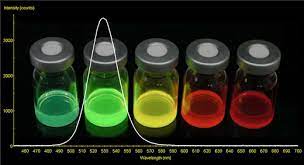Materials science is a field that continuously pushes the boundaries of what’s possible, and at the forefront of this exciting discipline are quantum dots (QDs). These tiny, remarkable nanocrystals have been making waves in the world of science and technology for several years now. In this article, we will delve deep into the fascinating realm of QDs, exploring what they are, why they are so intriguing, and how they are poised to reshape various industries.
What are quantum dots?
Before we delve into the reasons why QDs have captured the imagination of researchers and scientists, let’s first understand what these dots are.
QDs are nanometer-scale semiconductor particles made of various materials, including silicon, cadmium selenide, and indium phosphide. What distinguishes them is their minute scale, typically ranging from 2 to 10 nanometers, which is about 10,000 times tinier than the width of a human hair. Due to their diminutive size, these tiny wonders exhibit unique optical and electronic properties, making them exceptionally versatile in a wide range of applications.
What makes the appeal of QDs so multifaceted?
QDs have rapidly emerged as a hot topic in materials science for several compelling reasons. Let’s explore some of the factors that make these tiny particles so intriguing:
-
Spectacular Optical Properties
One of the most striking features of quantum dots is their exceptional optical properties. Their size-dependent bandgap allows for the fine-tuning of the emitted light, spanning the entire visible and near-infrared spectra. This attribute makes them ideal candidates for applications in optoelectronics and photonics.
These tiny particles have a high quantum yield, meaning they efficiently convert electrons into photons. This efficiency is superior to traditional organic dyes, making them highly desirable in applications like LED displays, quantum-dot solar cells, and biological imaging.
-
QDs and Energy Efficiency
The quest for energy-efficient lighting and displays has led to the rapid adoption of these tiny wonders in various industries. QD-enhanced displays are known for their ability to produce vibrant and lifelike colors while consuming less power. This energy efficiency is a critical factor in the development of eco-friendly technologies.
What are the applications of quantum dots?
As the adage goes, you can judge the pudding by its taste. QDs’ true potential is evident in the multitude of applications they are revolutionizing across different fields. Here are some notable applications:
-
Display Technology
These nanoparticles have been a game-changer in the world of display technology. Traditional LED displays often suffer from limited color gamut and energy inefficiency. QD displays, on the other hand, address these issues. They enable a wider color spectrum and consume less power, leading to energy-efficient TVs and monitors.
-
Quantum-Dot Solar Cells
Solar energy leads the charge in the shift toward sustainable energy sources. QD solar cells are designed to capture sunlight more efficiently due to their unique optical properties. By harnessing the entire solar spectrum, they promise higher energy conversion rates and a smaller ecological footprint.
-
Biomedical Imaging
In the realm of healthcare, the dots have found a significant role in improving the accuracy of medical diagnostics. These nanocrystals are employed as contrast agents in imaging techniques such as fluorescence microscopy. Their superior brightness and stability provide a clearer view of cellular structures and can aid in early disease detection.
-
Quantum Computing
Quantum computing, the future of computation, relies on the principles of quantum mechanics. QDs have the potential to play a pivotal role in the development of quantum computers. Their ability to capture and control individual electrons is a valuable asset for the creation of quantum bits or qubits, the fundamental units of quantum information processing.
What are some challenges and concerns?
While quantum dots hold immense promise, they are not without their challenges and concerns:
-
Toxicity and Environmental Impact
Some QDs contain heavy metals like cadmium, which can be toxic and pose environmental risks if not properly managed. Researchers are actively exploring ways to mitigate these concerns by developing more environmentally friendly QDs.
-
Production Costs
The synthesis of high-quality QDs can be expensive, limiting their widespread adoption in some applications. Reducing production costs remains a significant challenge for researchers and manufacturers.
-
Stability and Degradation
QDs are susceptible to degradation over time, impacting their long-term performance in various applications. Enhancing the stability of these tiny particles is a key area of research.
Future Prospects
As the field of materials science continues to advance, QDs are expected to play a pivotal role in shaping the future. Here are some exciting prospects:
-
QD-Based Quantum Computers
The development of quantum computers powered by QDs holds the promise of solving complex problems at speeds currently unimaginable. This technology could revolutionize fields like cryptography, drug discovery, and materials design.
-
Enhanced LED Lighting
Quantum-dot LEDs have the potential to replace traditional lighting sources and reduce energy consumption. This can lead to substantial energy conservation and a reduced carbon footprint, contributing to a greener and more sustainable future.
-
Advanced Medical Imaging
QDs can improve the resolution and sensitivity of medical imaging, potentially enabling early disease detection and personalized treatment plans. This could lead to significant advancements in healthcare.
-
Environmental Remediation
Research into eco-friendly QDs could pave the way for applications in environmental remediation, including the elimination of contaminants and the cleansing of water reservoirs. This could have a profound impact on addressing environmental challenges.
Conclusion
In conclusion, quantum dots are undeniably a hot topic in materials science for their unique properties and their potential to revolutionize various industries. From enhancing display technologies and solar cells to advancing medical diagnostics and potentially powering quantum computers, QDs are opening new frontiers in science and technology. While there are challenges to overcome, ongoing research and innovation are driving us closer to a future where these tiny wonders will play a central role in making the world a more efficient, sustainable, and technologically advanced place.


